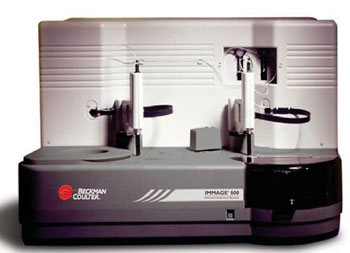Elevated C-Reactive Protein Found in H7N9 Influenza Infection
By LabMedica International staff writers
Posted on 13 Mar 2016
The avian influenza H7N9 virus can cause cytokine overproduction and result in severe pneumonia and acute respiratory distress syndrome; and many studies have focused on hypercytokinemia during avian influenza infection.Posted on 13 Mar 2016
C-reactive protein (CRP) is synthesized primarily by the liver, and is one of the nonspecific acute-phase proteins produced in response to most forms of infection inflammation, and tissue injury. This protein has been considered a nonspecific biomarker for early diagnosis and prognostic measurements.

Image: The IMMAGE 800 Immunochemistry System (Photo courtesy of Beckman-Coulter).
Infectious disease specialists at the Zhejiang University (Hangzhou, China) recruited 82 patients with laboratory-confirmed H7N9 infections from April 2013 to February 2014, and 14 patients with H1N1 virus in Beijing from December 2012 to February 2013, as well as six healthy volunteers as controls. Plasma samples were collected within two days of admission. Patient sputum samples or pharyngeal swabs were collected on the same day. Viral load was detected by TaqMan real-time reverse transcription polymerase chain reaction (PCR) targeting the influenza A H7N9 virus subtype-specific H7 gene or influenza A H1N1 virus subtype-specific H1 and N1 genes using standard thermal cycling conditions.
A Bio-Plex Pro Human 27-plex cytokine group I assay kit (Bio-Rad; Hercules, CA, USA) was used to measure the concentrations of plasma cytokines. Samples were analyzed using a MAGPIX system (Luminex Corporation, Merck Millipore; Temecula, CA, USA). Cytokine/chemokine values that were detected outside of the standard range were flagged as high or low out-of-range (OOR), and the highest or lowest value on the standard curve was used instead of the OOR measurement. Measurement of CRP in patient plasma was detected using a Beckman-Coulter IMMAGE 800 Immunohistochemistry System and Beckman-Coulter reagents (Beckman-Coulter; Brea, CA, USA).
The CRP levels were much higher in patients with H7N9 infection than in patients with H1N1 infection, 84.0 ± 65.2 mg/L compared to 11.37 ± 6.70 mg/L. The CRP concentration of the H1N1 group was significantly lower than those in the survivor and non-survivor H7N9 groups. Patients with H7N9 who died had much higher concentrations of CRP of 129.6 ± 63.9 mg/L. Several cytokines, including Macrophage inflammatory protein-1β (MIP-1β), Monocyte chemoattractant protein-1(MCP-1), Interferon gamma-induced protein 10 (IP-10), and interleukin-6 (IL-6), were observed to have significantly positive relationships with CRP levels, whereas IL-17A was negatively associated with CRP levels.
The authors concluded that CRP, as a conventional clinical indicator, could be a simple and convenient marker for the early prediction of potential cytokine storms, particularly when cytokine detection is unavailable. This marker will contribute to the early identification of high-risk cases, further assessment of cytokine profiles of severe cases, and the development of an appropriate therapeutic plan, such as anti-cytokine treatment. The study was published in the March 2016 edition of the International Journal of Infectious Disease.
Related Links:
Zhejiang University
Luminex Corporation
Beckman-Coulter









 Analyzer.jpg)



